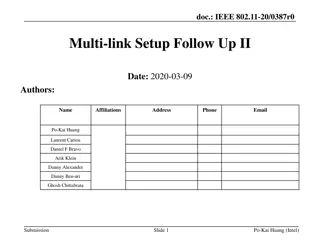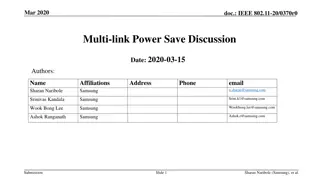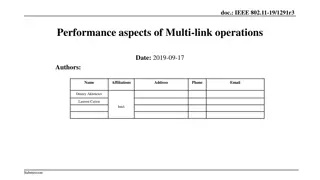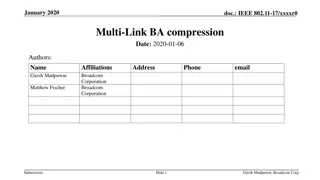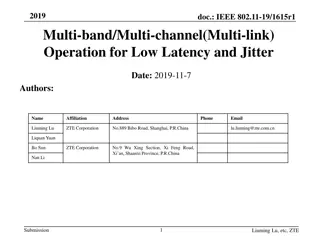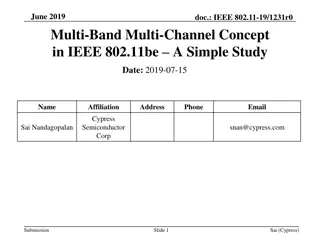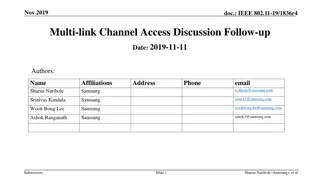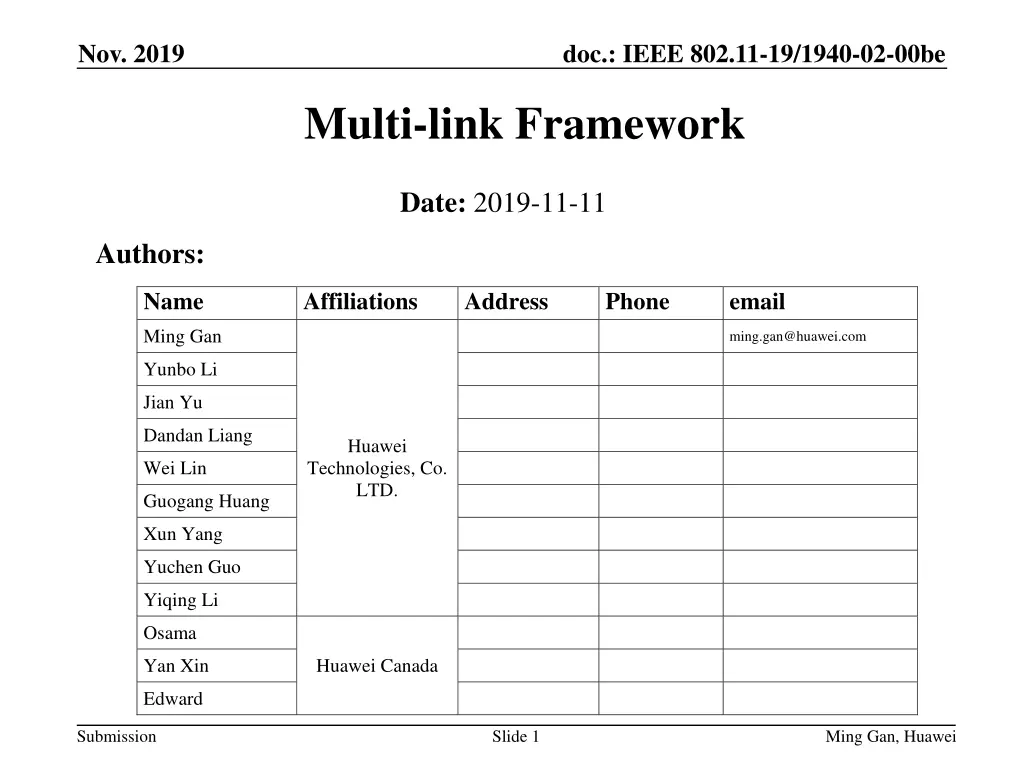
IEEE 802.11-19 Multi-link Framework Discussion
Explore the IEEE 802.11-19 document discussing the Multi-link Framework, defining Multi-link logical entities and devices, addressing issues related to terminology and categorization of STAs within the framework. The document delves into the classification of non-tunable and tunable single-band STAs as multi-link devices and examines the differences between single-band STAs and multi-link devices in terms of traffic management and link utilization.
Download Presentation

Please find below an Image/Link to download the presentation.
The content on the website is provided AS IS for your information and personal use only. It may not be sold, licensed, or shared on other websites without obtaining consent from the author. If you encounter any issues during the download, it is possible that the publisher has removed the file from their server.
You are allowed to download the files provided on this website for personal or commercial use, subject to the condition that they are used lawfully. All files are the property of their respective owners.
The content on the website is provided AS IS for your information and personal use only. It may not be sold, licensed, or shared on other websites without obtaining consent from the author.
E N D
Presentation Transcript
Nov. 2019 doc.: IEEE 802.11-19/1940-02-00be Multi-link Framework Date: 2019-11-11 Authors: Name Affiliations Address Phone email Ming Gan ming.gan@huawei.com Yunbo Li Jian Yu Dandan Liang Huawei Wei Lin Technologies, Co. LTD. Guogang Huang Xun Yang Yuchen Guo Yiqing Li Osama Yan Xin Huawei Canada Edward Submission Slide 1 Ming Gan, Huawei
Nov. 2019 doc.: IEEE 802.11-19/1940-02-00be Recap Multi-link logical entity: A logical entity that has one or more affiliated STAs. The logical entity has one MAC data service interface and primitives to the LLC and a single address associated with the interface, which can be used to communicate on the DSM [1]. NOTE A Multi-link logical entity allows STAs affiliated with the multi-link logical entity to have the same MAC address NOTE The exact name can be changed Multi-link operation (MLO) device: A logical entity that enables common management signaling between a collection of one or more Multi-Link Logical Entities (MLLEs) [2] Note the exact name can be changed later Submission Slide 2 Ming Gan, Huawei
Nov. 2019 doc.: IEEE 802.11-19/1940-02-00be Framework This two-layer structure [2] shown below conflicts the terminology of device in 802.11md as described in [3] There are two layers for multi-link concept, the lower layer is entity, the upper layer is device. However, all of these two layers belong to the terminology of device in 802.11md The definition for each layer is vague Each layer has an exception One STA in a lower layer could be categorized as multi-link entity One multi-link entity in an upper layer could be categorized as multi-link device In this contribution, we try to solve the above issues Claim that One STA does not belong to multi-link, but we are open to add new operation for this STA if needed Try to reuse the existing architectures or do some minor change on them We do not touch any related operation, such as FST, about multi-link. It could be discussed later DS DS MLO Device Manages signaling across MLLE 1 and MLLE 2 MAC Addr (M1) MAC Addr (M2) MAC-SAP-a MAC-SAP-b MLLE 2 Common BA session, SN, security MLLE 1 Common BA session, SN, security STA (MAC/PHY) x STA (MAC/PHY) y STA (MAC/PHY) z WM WM WM Submission Slide 3 Ming Gan, Huawei
Nov. 2019 doc.: IEEE 802.11-19/1940-02-00be Could One STA Belong to Multi-link? Now for the STA, we have non-tunable single band STA, or tunable single band STA For non-tunable single band STA, it only supports one band/sub-band, but can change the operating channel within this band/sub-band. The range of working frequency is relative small For tunable single band STA, it can support more than one band/sub-band but work in one band at a time. The range of working frequency is relative large Reference [4] regarded a special case (a STA) as multi-link logical entity A STA that only supports one radio (original name in [4]), but could camp on different links Base on the above descriptions, both non-tunable single band STA and tunable single band STA can be regarded as multi-link device However, such categorization is not reasonable First, it does not keep consistent with multi-band capable device in the draft where it has more than one STA There is big difference between STA and multi-link device, one only allows the traffic to be sent in one link at a time, but the other allows the traffic to be sent more than one link simultaneously No more extra one link maintenance work like multi-link device for single band STA because only one link is configured to work at a time and this configuration is much quasi-static Slide 4 Submission Ming Gan, Huawei
Nov. 2019 doc.: IEEE 802.11-19/1940-02-00be Could One STA Belong to Multi-link? Besides the categorization, is there any necessity to simplify the protocols for single band STA in 802.11be? We are open to it, but we need evaluate its benefit first How often does the single band STA change its working channel How much is the overhead for one extra link maintenance for single band STA Now we also have neighbor report, fast BSS transition, BSS transition management and so on in the draft to achieve the traffic steering for the single band STA. Are they enough? In the context of multi-link AP device, is there any other work to do? Submission Slide 5 Ming Gan, Huawei
Nov. 2019 doc.: IEEE 802.11-19/1940-02-00be The existing architectures in 802.11REVmd D3.0 In 802.11REVmd D3.0 (4.9.4 Reference model for multi-band operation), it says A multi-band capable device can manage operation over more than one frequency band/channel. The operation across the different frequency bands/channels can be simultaneous or nonsimultaneous. A multi-band capable device can also support multiple MAC sublayers. The multi-band procedures (see 11.32 (Multi-band operation)) allow a pair of multi-band capable devices to discover, synchronize, (de)authenticate, (re)associate, disassociate, and manage resources with each other on any common band/channel that is supported by both STAs. There are two kinds of multi-band capable device One is to support transparent FST Only supports the function of flow level[2] But all the STAs share the same MAC SAP as packet level architecture [2] and multi-link logical entity [1] Submission Slide 6 Ming Gan, Huawei
Nov. 2019 doc.: IEEE 802.11-19/1940-02-00be The existing architectures in 802.11REVmd D3.0 The other supports non-transparent FST Only supports the function of flow level[2] And each STA has its own MAC SAP as the flow level architecture [2] Here we just want to point out that architectures exist in draft. Based on the above reference models, we propose a clear terminology for multi-link in the next slide Try to reuse the existing architectures, and keep consistent with terminology of multi-band capable device Submission Slide 7 Ming Gan, Huawei
Nov. 2019 doc.: IEEE 802.11-19/1940-02-00be Multi-link capable device Multi-link capable device: A device that has more than one affiliated STA, which can operate in different frequency bands/channels. Multi-link capable transparent device: A device that has more than one affiliated STA, which can operate different frequency bands/channels. The device has a single MAC SAP presented to the logical link control (LLC) layer for all of the affiliated STAs that are identified by one common MAC address. Whether the affiliated STA has its own MAC address is TBD Multi-link capable non-transparent device: A device that has more than one affiliated STA, which can operate in different frequency bands/channels. The device has a single MAC SAP presented to the logical link control (LLC) layer for each affiliated STA that is identified by a MAC address. Multi-link capable AP device: A multi-link capable device, where each affiliated STA is an AP. Multi-link capable non-AP device: A multi-link capable device, where each affiliated STA is a non-AP STA Submission Slide 8 Ming Gan, Huawei
Nov. 2019 doc.: IEEE 802.11-19/1940-02-00be Summary A more accurate unified framework for multi-link operation is proposed and it keeps the consistent with the existing architectures of the related multi-band capable device in the draft Multi-link capable device, multi-link capable transparent device and multi-link capable non- transparent device Do some minor change on them without any conflict, an example of the minor change: replace Transparent FST Entity in the figure of slide 4 with Common high MAC . To facilitate the process of the multi-link feature, we suggest to discuss the operations for multi-link capable transparent device and multi-link capable non- transparent device separately They may be combined after full discussion later Submission Slide 9 Ming Gan, Huawei
Nov. 2019 doc.: IEEE 802.11-19/1940-02-00be References [1] IEEE 802.11-19/0773r7 Multi-link Operation framework [2] IEEE 802.11-19/0823r2 Multi-link aggregation [3] IEEE 802.11-19/1231r3 Multiband and Multichannel Operation in IEEE 802.11be [4] IEEE 802.11-19/1542r0 multi-link broadcast addressed frame reception Submission Slide 10 Ming Gan, Huawei
Nov. 2019 doc.: IEEE 802.11-19/1940-02-00be SP 1 Multiple MAC SAPs Multi-Link device (MMLD): A device that has more than one affiliated STA and has more than one MAC SAP to the LLC. Note-The device can be logic Submission Slide 11 Ming Gan, Huawei
Nov. 2019 doc.: IEEE 802.11-19/1940-02-00be Backup Q: Could we still use the terminology of multi-band capable device for 802.11be A: Suggest to change multi-band to multi-link, in order to match the multi-link feature in 802.11be well. Meanwhile we can reuse the existing architectures of multi-band capable device or do some minor change on them without any conflict, an example of the minor change: replace Transparent FST Entity in the figure of slide 4 with Common high MAC . Q: What is the relationship between FST and this proposal. A: FST is the protocol of multi-band operation based on the architectures of multi-band capable device in the REVmd D3.0. However, this proposal does not touch any related operation protocols for the multi-link capable device. The group could think about the more advanced protocols to meet the new requirement in 802.11be. Q: What is the relationship between FST and multi-link operation A: Although FST and multi-link operation are all based on the existing architectures in the draft with slight difference, they could be different. Submission Slide 12 Ming Gan, Huawei
Nov. 2019 doc.: IEEE 802.11-19/1940-02-00be SP 0 Multi-Link Device (MLD): A device that has more than one affiliated STA and has one MAC data service to the LLC with a single MAC SAP MAC address associated with MAC data service, which can be used to communicate on the DSM. The WM MAC address of each STA affiliated with the MLD is TBD Multiple MAC SAPs Multi-Link device (MMLD): A device that has more than one affiliated STA and more than one MAC data service to the LLC with a MAC SAP MAC address per MAC data service, which can be used to communicate on the DSM. Submission Slide 13 Ming Gan, Huawei
Nov. 2019 doc.: IEEE 802.11-19/1940-02-00be SP 1 Multi-link capable device: A device that has more than one affiliated STA, which can operate in different frequency bands/channels. Multi-link capable transparent device: A device that has more than one affiliated STA, which can operate different frequency bands/channels. The device has a single MAC SAP presented to the logical link control (LLC) layer for all of the affiliated STAs that are identified by one common MAC address. Whether the affiliated STA has its own MAC address is TBD Multi-link capable non-transparent device: A device that has more than one affiliated STA, which can operate in different frequency bands/channels. The device has a single MAC SAP presented to the logical link control (LLC) layer for each affiliated STA that is identified by a MAC address. Submission Slide 14 Ming Gan, Huawei
Nov. 2019 doc.: IEEE 802.11-19/1940-02-00be SP2 Multi-link capable AP device: A multi-link capable device, where each affiliated STA is an AP. Multi-link capable non-AP device: A multi-link capable device, where each affiliated STA is a non-AP STA Submission Slide 15 Ming Gan, Huawei


